Content Menu
● The Basics of Fabric Construction
● Swimwear Fabric Requirements
● Knitted Fabrics in Swimwear
● Types of Knitted Fabrics Used in Swimwear
● Woven Fabrics in Swimwear
● The Evolution of Swimwear Fabrics
● Sustainability in Swimwear Fabrics
● The Role of Technology in Swimwear Fabric Development
● Caring for Swimwear Fabrics
● The Art and Science of Swimwear Design
● The Future of Swimwear Fabrics
● Conclusion
● Video Resources
● Frequently Asked Questions
>> Q: Why is most swimwear made from knitted fabrics rather than woven fabrics?
>> Q: What are the most common materials used in swimwear fabrics?
>> Q: How do I care for my swimwear to ensure it lasts longer?
>> Q: Are there any sustainable options for swimwear fabrics?
>> Q: How does the fabric choice affect the performance of competitive swimwear?
When it comes to swimwear, one of the most common questions that arise is whether swimsuits are woven or knitted. This seemingly simple question opens up a fascinating world of textile technology, fashion design, and the intricate balance between form and function in swimwear. To truly understand the nature of swimwear fabrics, we need to dive deep into the realms of textile manufacturing, exploring the characteristics of both woven and knitted fabrics, and how they apply to the unique demands of swimwear.
The Basics of Fabric Construction
Before we can answer whether swimwear is woven or knitted, it's essential to understand the fundamental differences between these two fabric construction methods.
1. Woven Fabrics: Woven fabrics are created by interlacing two sets of yarns at right angles to each other. The lengthwise yarns are called the warp, while the crosswise yarns are known as the weft. This interlacing process creates a stable, often less stretchy fabric with a distinct grid-like structure when examined closely.
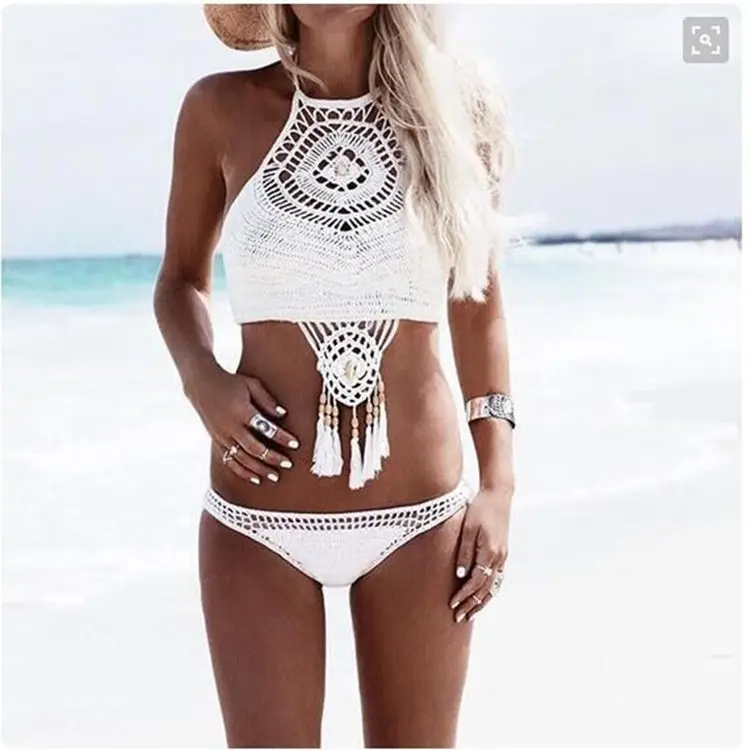
2. Knitted Fabrics: Knitted fabrics, on the other hand, are created by interlocking loops of yarn. This construction method results in a more flexible, stretchy fabric with excellent drape. Knitted fabrics can be further categorized into weft knits (like t-shirt material) and warp knits (like tricot).
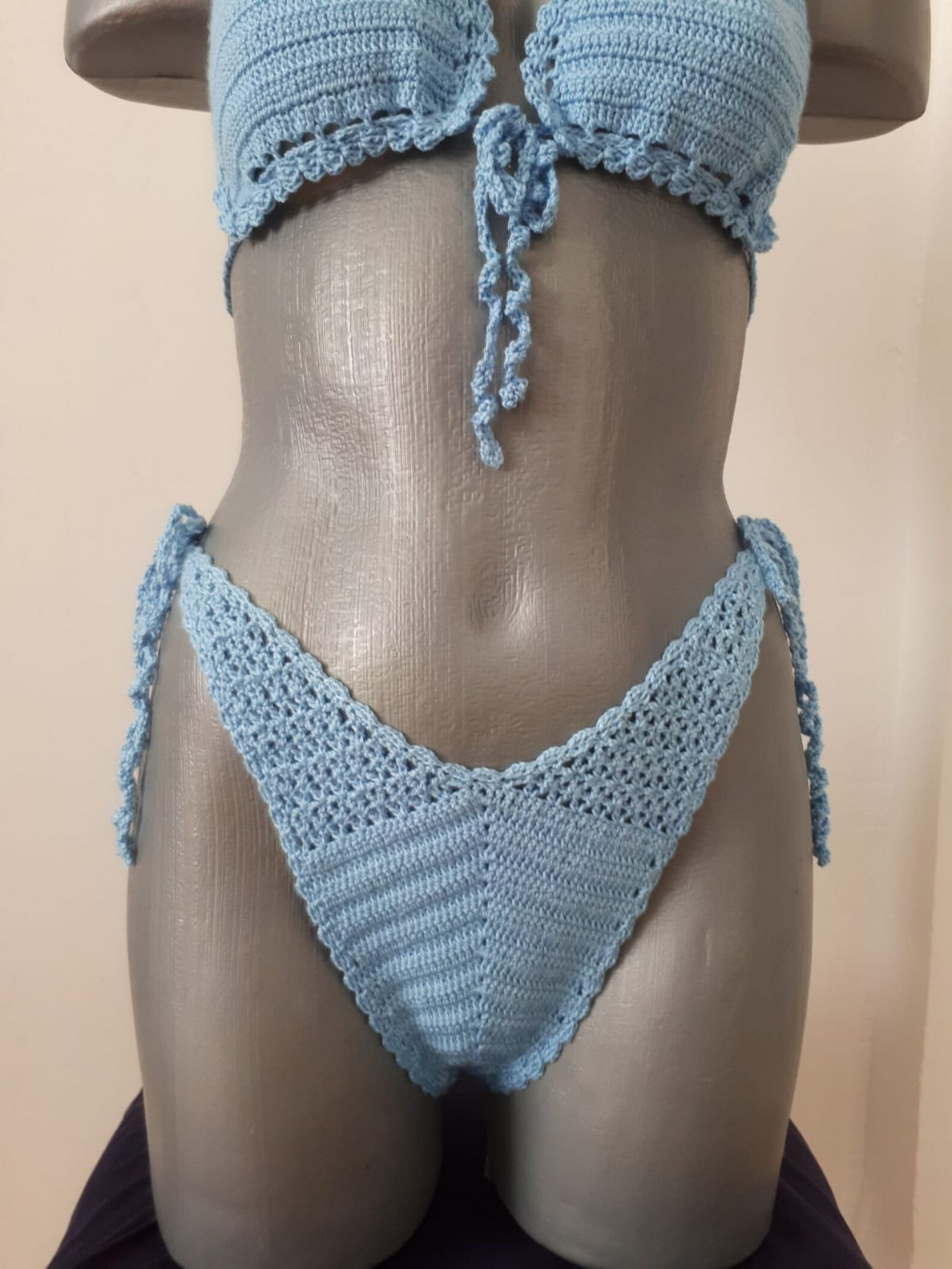
Now that we've established the basic differences between woven and knitted fabrics, let's explore how these characteristics apply to swimwear.
Swimwear Fabric Requirements
Swimwear presents a unique set of challenges for fabric selection. The ideal swimwear fabric must possess several key properties:
1. Stretch and Recovery: Swimwear needs to conform to the body's contours while allowing for freedom of movement. It should also maintain its shape after repeated wear and exposure to water.
2. Durability: The fabric must withstand exposure to chlorine, saltwater, sunlight, and other environmental factors without degrading quickly.
3. Quick-drying: A good swimwear fabric should dry rapidly to prevent discomfort and reduce the growth of bacteria.
4. Color retention: The fabric should resist fading from exposure to sun, chlorine, and saltwater.
5. Comfort: The material should feel soft against the skin and not cause irritation, even when wet.
6. UV protection: Many modern swimwear fabrics incorporate UV-protective properties to shield the wearer from harmful sun rays.
Given these requirements, let's examine how woven and knitted fabrics measure up.
Knitted Fabrics in Swimwear
The vast majority of modern swimwear is made from knitted fabrics. Here's why:
1. Superior Stretch: Knitted fabrics offer excellent four-way stretch, allowing the swimsuit to mold to the body's contours and move with the wearer. This is crucial for both comfort and performance in the water.
2. Shape Retention: Quality knitted swimwear fabrics have excellent recovery properties, meaning they return to their original shape after being stretched. This helps swimsuits maintain their fit over time.
3. Comfort: The inherent flexibility of knitted fabrics makes them more comfortable against the skin, especially when wet.
4. Variety of Textures: Knitted fabrics can be engineered to create various textures and patterns within the fabric itself, allowing for interesting design elements without compromising on performance.
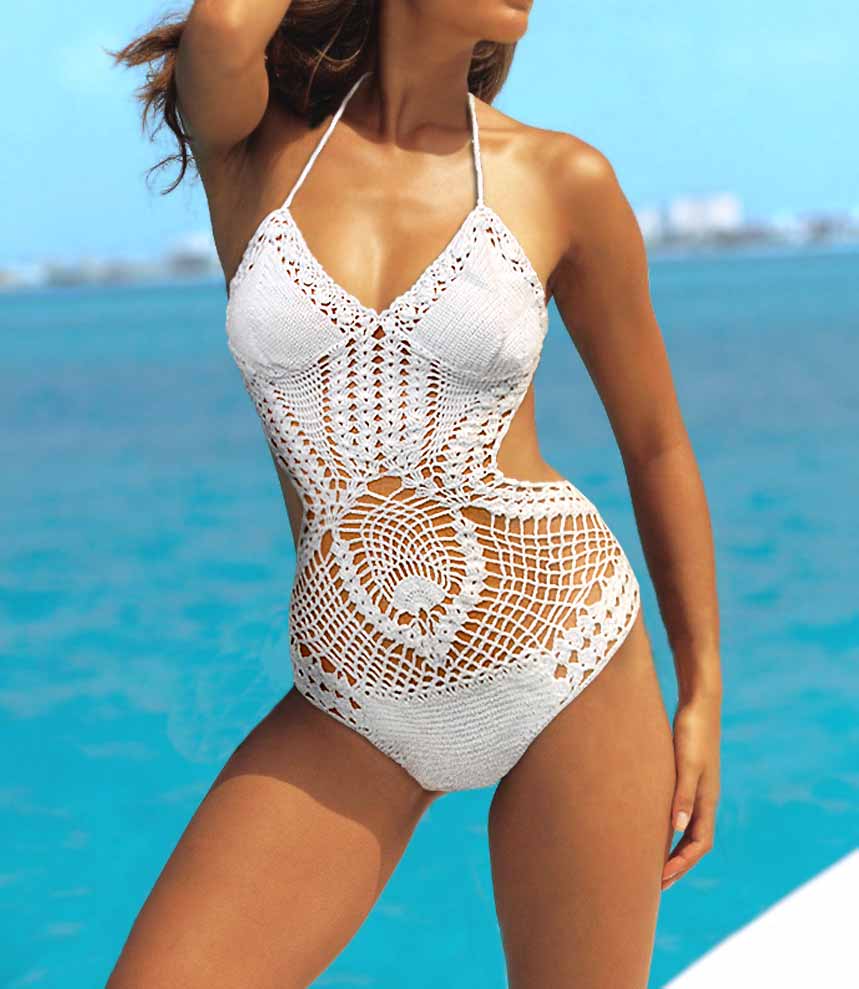
Types of Knitted Fabrics Used in Swimwear
1. Nylon-Spandex Blends: These are perhaps the most common swimwear fabrics. Nylon provides strength and quick-drying properties, while spandex (also known as elastane or Lycra) adds stretch and shape retention.
2. Polyester-Spandex Blends: Similar to nylon blends, but with enhanced chlorine resistance and color retention properties.
3. Ribbed Knits: These fabrics feature alternating ridges and grooves, providing texture and often a more compressive fit.
4. Jacquard Knits: These fabrics have patterns knitted directly into the fabric, allowing for intricate designs without the need for printing.
Woven Fabrics in Swimwear
While less common than knitted fabrics, woven materials do have their place in the world of swimwear:
1. Board Shorts and Swim Trunks: Men's swim shorts are often made from woven polyester or nylon fabrics. These materials provide durability and quick-drying properties, though they typically have less stretch than knitted swimwear.
2. Cover-ups and Resort Wear: Many beach cover-ups and resort wear items are made from woven fabrics like cotton or rayon, providing a different texture and appearance compared to the swimsuit itself.
3. Structural Elements: Some swimsuits incorporate woven fabrics in specific areas for added support or design elements, such as a woven lining or decorative panels.
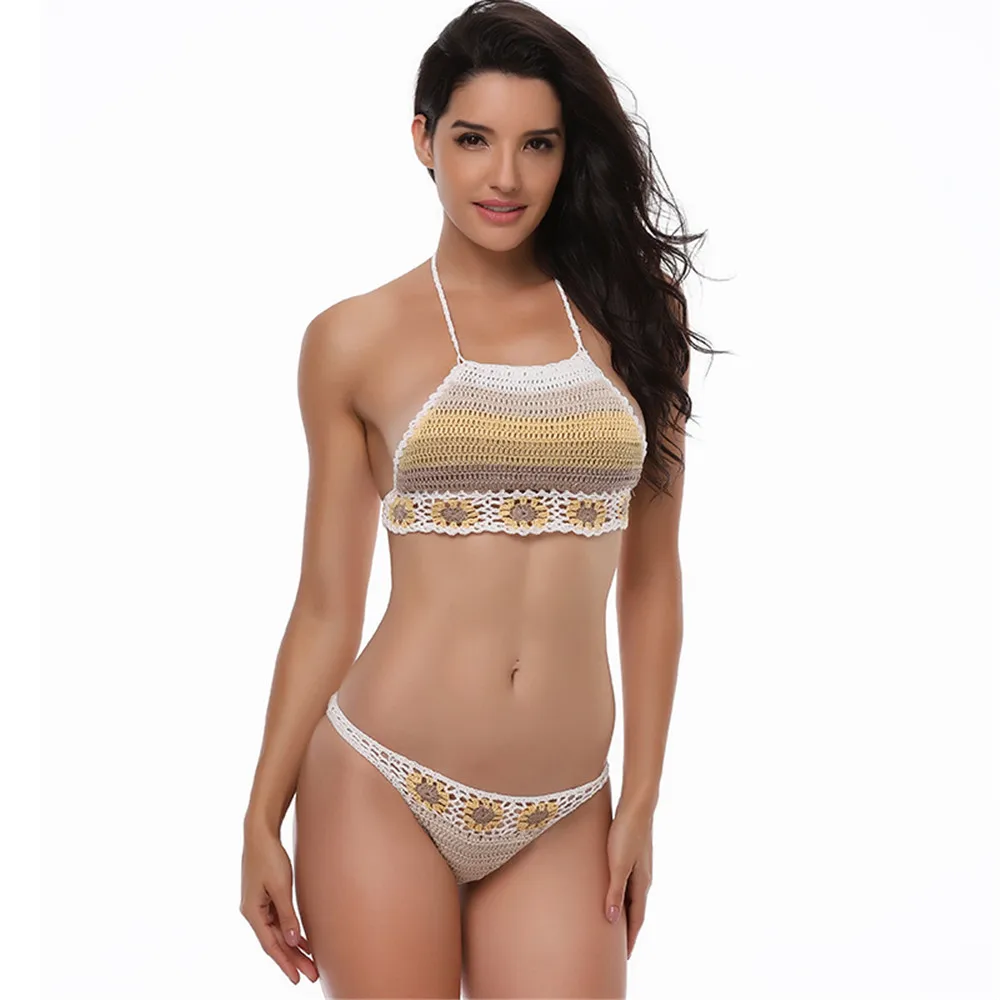
The Evolution of Swimwear Fabrics
The history of swimwear fabrics is a fascinating journey that reflects advancements in textile technology and changing societal norms.
Early Swimwear: In the early 20th century, swimsuits were often made from woven wool fabrics. While wool has natural water-repellent properties, these suits were heavy, uncomfortable when wet, and not particularly form-fitting.
The Rise of Synthetic Fibers: The invention of nylon in the 1930s revolutionized swimwear. Nylon's strength, light weight, and quick-drying properties made it ideal for swimsuits. The introduction of spandex (Lycra) in the 1960s further transformed swimwear, allowing for the creation of form-fitting, stretchy suits.
Modern Innovations: Today's swimwear fabrics are high-tech marvels. Advanced knitting techniques allow for the creation of fabrics with varying levels of compression and support in different areas of the suit. Some fabrics incorporate microencapsulated substances that release skin-nourishing moisturizers or UV-protective compounds.
Sustainability in Swimwear Fabrics
As environmental concerns become increasingly important in the fashion industry, swimwear manufacturers are exploring more sustainable fabric options:
1. Recycled Polyester: Made from post-consumer plastic bottles, this fabric reduces waste while maintaining the performance properties needed for swimwear.
2. Econyl: This regenerated nylon is made from recycled fishing nets and other nylon waste, offering a sustainable alternative to virgin nylon.
3. Natural Fiber Blends: Some brands are experimenting with blends that incorporate natural fibers like organic cotton or hemp, particularly for cover-ups and resort wear.
The Role of Technology in Swimwear Fabric Development
Advancements in textile technology continue to push the boundaries of what's possible in swimwear fabrics:
1. Compression Fabrics: These high-tech knits provide muscle support and can even help improve circulation, making them popular for competitive swimwear.
2. Biomimetic Fabrics: Inspired by shark skin, some swimwear fabrics are designed with microscopic ridges to reduce drag in the water, potentially improving swim speeds.
3. Smart Fabrics: While still in development, future swimwear might incorporate conductive fibers to monitor vital signs or even change color based on temperature or UV exposure.
Caring for Swimwear Fabrics
To ensure the longevity of swimwear, proper care is essential:
1. Rinse after use: Always rinse swimwear in fresh water after exposure to chlorine or saltwater.
2. Hand wash: Use a mild detergent and gently hand wash to preserve the fabric's elasticity.
3. Avoid heat: Air dry swimwear away from direct sunlight, and never use a dryer, as heat can damage the elastic fibers.
4. Rotate suits: If possible, alternate between different swimsuits to allow each one time to fully recover its shape between wears.
The Art and Science of Swimwear Design
Creating the perfect swimsuit involves a delicate balance between aesthetics and functionality. Designers must consider not only how a suit looks but how it will perform in water and hold up to the harsh conditions of sun, salt, and chlorine.
The choice between woven and knitted fabrics plays a crucial role in this process. While knitted fabrics dominate the swimwear market due to their superior stretch and recovery properties, woven fabrics still have their place, particularly in men's swim shorts and certain design elements.
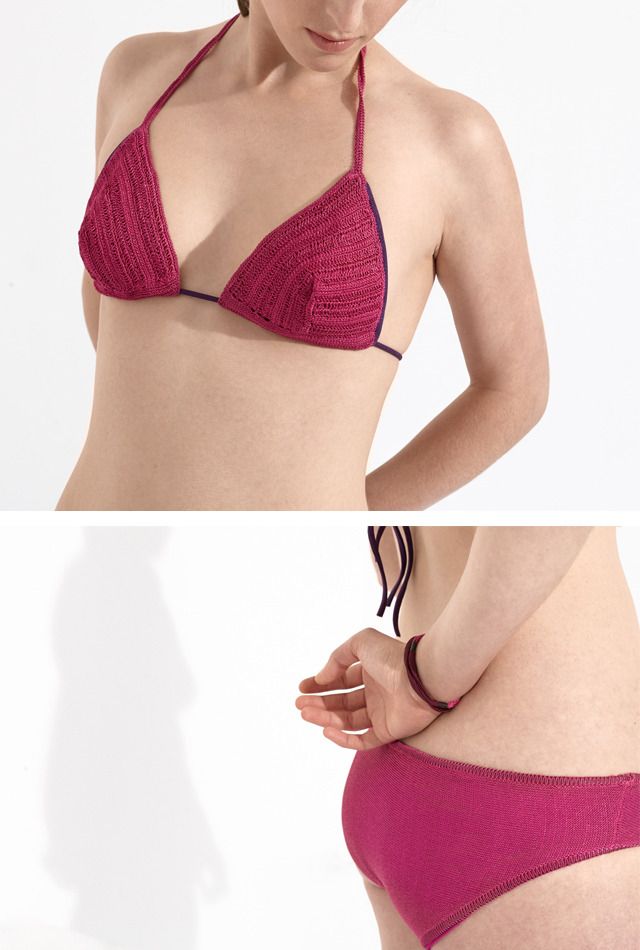
Designers often use a combination of different knit structures within a single swimsuit to provide varying levels of support, compression, and visual interest. For example, a one-piece swimsuit might use a more compressive knit fabric in the torso for tummy control, while using a stretchier knit in the bust and hip areas for comfort and ease of movement.
The Future of Swimwear Fabrics
As we look to the future, it's clear that innovation in swimwear fabrics will continue to evolve. We can expect to see:
1. Enhanced Performance: Fabrics that offer even better UV protection, improved chlorine resistance, and faster drying times.
2. Greater Sustainability: Increased use of recycled and biodegradable materials as the fashion industry moves towards more eco-friendly practices.
3. Smart Textiles: Integration of technology into swimwear fabrics, potentially offering features like temperature regulation or even digital displays.
4. Customization: Advancements in 3D knitting technology may lead to more personalized swimwear, with fabrics tailored to individual body shapes and performance needs.
Conclusion
So, is swimwear woven or knitted? While both types of fabrics have their place in the world of swimwear, the majority of modern swimsuits are made from knitted fabrics. The superior stretch, recovery, and comfort of knitted fabrics make them ideal for the unique demands of swimwear.
However, the world of swimwear fabrics is diverse and ever-evolving. From high-performance competitive suits to fashionable beachwear, the choice of fabric plays a crucial role in both the function and aesthetics of swimwear. As technology advances and consumer demands change, we can expect to see continued innovation in this fascinating intersection of textile science and fashion design.
Whether you're a competitive swimmer, a beach enthusiast, or simply someone who appreciates the engineering behind everyday garments, understanding the intricacies of swimwear fabrics adds a new dimension to your next dip in the pool or ocean.
Video Resources
1. For a visual explanation of the differences between knit and woven fabrics, check out this informative video: Knits vs Woven: Master Fabric Types In 5 Minutes
2. To learn more about choosing the right swimsuit fabric, this video offers valuable insights: How to Choose Swimsuit Fabric
3. For those interested in sewing their own swimwear, this comprehensive guide covers everything from fabric selection to construction techniques: The Ultimate Guide To Sewing Swimwear and Activewear
Frequently Asked Questions
Q: Why is most swimwear made from knitted fabrics rather than woven fabrics?
A: Knitted fabrics are preferred for swimwear because they offer superior stretch and recovery properties, allowing the swimsuit to conform to the body's contours and move with the wearer. They also tend to be more comfortable and retain their shape better after repeated wear and exposure to water.
Q: What are the most common materials used in swimwear fabrics?
A: The most common materials used in swimwear fabrics are synthetic fibers such as nylon and polyester, usually blended with a stretchy fiber like spandex (also known as elastane or Lycra). These blends provide the necessary stretch, durability, and quick-drying properties required for swimwear.
Q: How do I care for my swimwear to ensure it lasts longer?
A: To care for your swimwear, always rinse it in fresh water after use, especially if exposed to chlorine or saltwater. Hand wash with a mild detergent, avoid wringing or twisting the fabric, and air dry away from direct sunlight. Never use a dryer, as heat can damage the elastic fibers in the fabric.
Q: Are there any sustainable options for swimwear fabrics?
A: Yes, there are increasingly more sustainable options for swimwear fabrics. These include recycled polyester made from post-consumer plastic bottles, Econyl (a regenerated nylon made from recycled fishing nets and other nylon waste), and blends that incorporate organic or recycled natural fibers.
Q: How does the fabric choice affect the performance of competitive swimwear?
A: The fabric choice significantly affects competitive swimwear performance. High-tech knitted fabrics can provide muscle compression, which may improve circulation and reduce muscle fatigue. Some fabrics are engineered to reduce drag in the water, potentially improving swim speeds. The fabric's ability to retain its shape and resist degradation from chlorine is also crucial for consistent performance over time.




































































